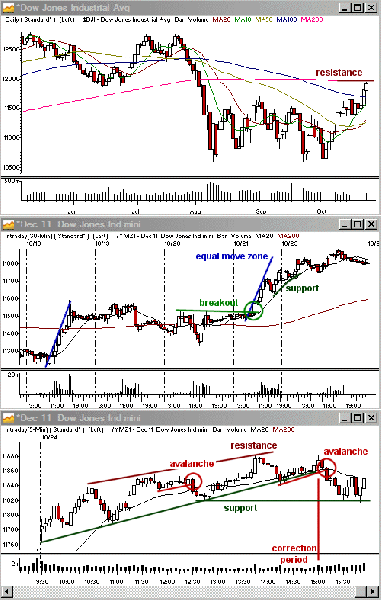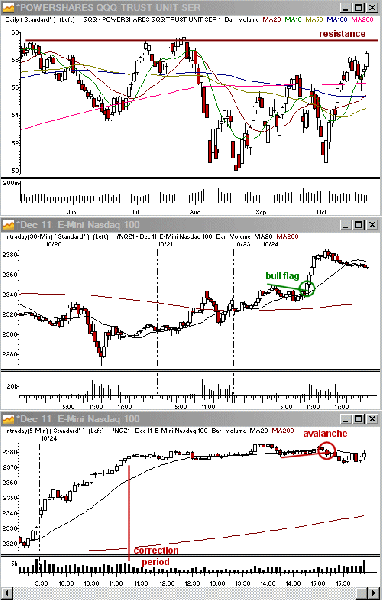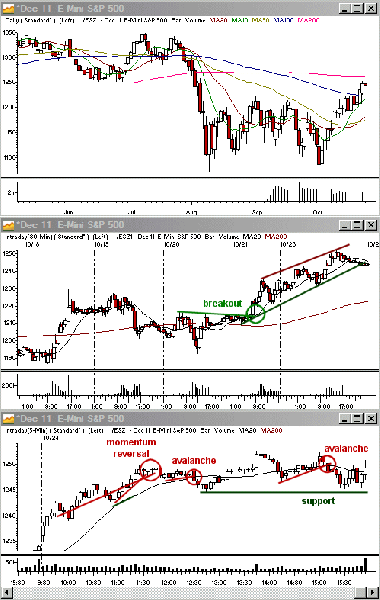(Note: Unless otherwise stated, the index action described below relates to the EMini futures contracts for the respective indices. Actual index action may differ slightly in terms of pattern formation, although the market bias will remain the same.)
TUESDAY’S MARKET WRAP-UP
Market Snapshot for November 1, 2011 (5:12 a.m. ET):
Closing Prices: DOW 11,657.96 (-297.05, -2.48%), S&P 500 1,218.28 (-35.02, -2.79%), NASDAQ 2,606.96 (-77.45, -2.89%), Nikkei 225 8,835.52 (-152.87, -1.7), DAX 5,834.51 (-306.83, -5%), FTSE 5,421.57 (-122.65, -2.21%)
OIL 91.64, GOLD 1,721.00, SILVER 33.315
EURO 1.3692, YEN 78.34, BRITISH POUND 1.5946, U.S. DOLLAR INDEX 77.455
Market Takes Its Cue From Europe
The market is always impacted by the latest global headlines, but over the past several weeks this has been particularly true. Although strategies develop technically, it’s overall market sentiment that leads to these technical setups. Lately that sentiment has been quite bipolar. Sharp upside on hopes that meetings among European Union leaders would be fruitful in developing a solution to the region’s debt crisis were followed by the realization that there is no “quick fix” and officials are divided on how to best mitigate the disastrous situation.
In the meantime, corporate earnings have also been grabbing headlines. This is the last “big week” of third quarter earnings season and while earnings have consistently topped analysts’ expectations, most of the growth has been abroad. Companies relying upon strength in the U.S. and Europe have mostly fallen short. Comcast (CMCSA) and Time Warner (TWX) are on the docket for Wednesday ahead of the opening bell, while Kraft Foods (KFT) reports after the close.
Playing the Fed Decision
Also making headlines on Wednesday will be the U.S. FOMC interest rate and policy announcement coming up at 2:15 ET. Interest rates are expected to remain unchanged, so eyes and ears are on the accompanying policy statement. In the past, the market often had wild swings in price action following the Fed, but over the past several years those reactions tamed down as the Fed went into a holding pattern on interest rates. Recently, however, the accompanying statement on economic outlook has stirred things up once again and the market’s reaction following the announcement has been amplified.
A typical Fed day plays out as follows: Often there is upside in the morning, often out of the open (less common as Fed reactions diminished). This is followed by a slowdown mid-day as market participants move to the sidelines in anticipation of the news. Trading becomes higher risk simply due to this lack of participation and setups have diminished follow-through.
After the announcement, the market usually has two sets of reactive moves consisting of three waves each. An initial reaction on the 1 minute time frame is followed by a second, counter-move that can be more extreme than the initial reaction. This means that technical biases, such as a breakdown, can trigger following the announcement and then be flushed out shortly thereafter before the third move takes place that confirms the initial bearish bias. This makes trading that initial reaction the highest risk. This set of three is then repeated on a five minute time frame with the first three waves on the one minute charts making up the initial move on the five minute one.
More News From Europe on the Horizon
Even with the additional news out of the States, Europe will still continue to grab the spotlight when the region’s leaders meet at the G-20 summit in Cannes from November 3-4. The European Central Bank’s interest rate announcement will also be out this week on Thursday.

Dow Jones Industrial Average (Figure 1)
Tuesday’s Economic Reports
Tuesday’s economic reports in the U.S. had little impact upon the session’s price action. The news was unwelcome, but after sharp selling, the market was already exhausted intraday on the downside by the time it hit. The ISM Manufacturing Index fell from 51.6 in September to 50.8 in October. It had been expected to move higher to 52.1. Meanwhile, construction spending was higher by 0.2% in September, but fell short of expectations. It had been higher by 1.4% the previous month.

S&P 500 (Figure 2)
Index Wrap-up
The Dow Jones Industrial Average ($DJI) ended the day on Tuesday with a loss of 297.05 points, or 2.48%, and closed at 11,657.96. Most of the day’s losses came overnight and the market traded in a range throughout the day. All of the Dow’s thirty index components posted a loss except Pfizer (PFE) (+0.36%), which managed to pull higher following stronger-than-anticipated quarterly earnings. The weakest were the financials: Bank of America (BAC) (-6.30%) and JP Morgan (JPM) (-5.90%). Cisco Systems (CSCO) (-5.13%) also posted a loss over 5%.
The S&P 500 ($SPX) finished the session with a loss of 35.02 points, or 2.79%, and closed at 1,218.28. The strongest individual percentage performers were ITT Corp. (ITT) (+7.24%), Expedia (EXPE) (+4.27%), and American Tower Corp. (AMT) (+3.30%). None of the index’s industry groups, however, managed a gain. The weakest stocks fell in the financials, energy, and industrials. The top percentage decliners were MetroPCS Communications (PCS) (-9.88%), Hudson City Bankcorp (HCBK) (-9.28%), and Advanced Micro Devices (AMD) (-9.09%).
The Nasdaq Composite ($COMPX) ended the session lower by 77.45 points, or 2.89%, on Tuesday and it closed at 2,606.96. Only four components in the Nasdaq-100 ($NDX) posted a gain. The strongest were Expedia (EXPE) (+4.27%) and Seagate Tech. (STX) (+1.75%). The weakest were Schein Henry (HSIC) (-7.17%), First Solar (FSLR) (-6.01%), and Micron Tech. (MU) (-5.37%).

Nasdaq Composite (Figure 3)
For more information, please visit: http://www.tonihansen.com.



